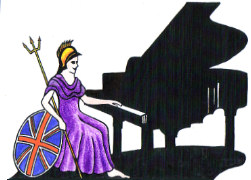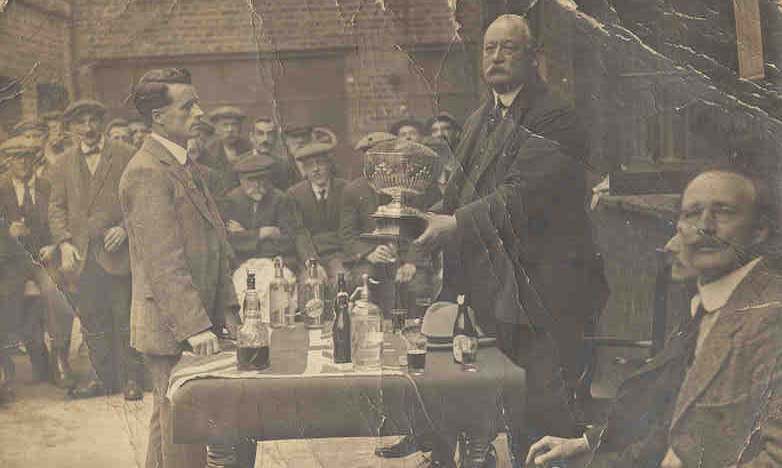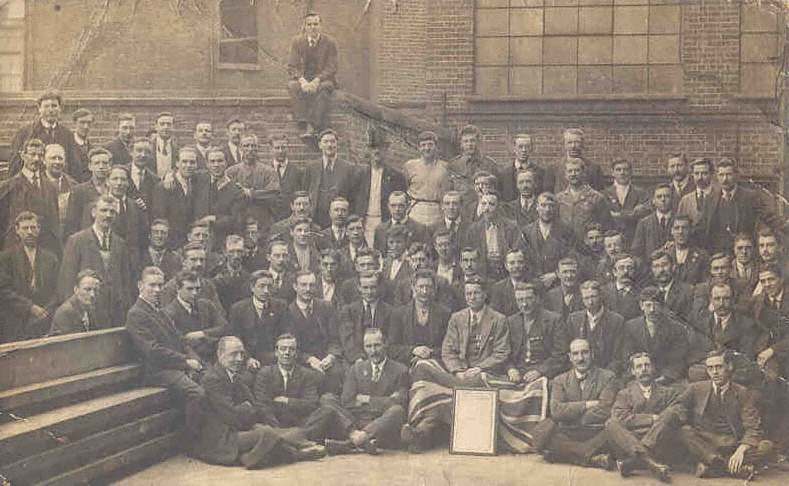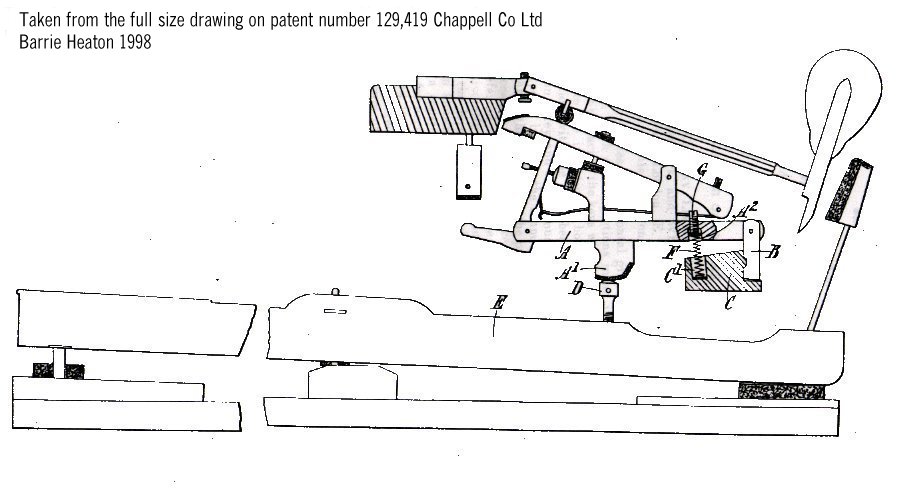A History of Chappell Pianos of Bond Street, London

UK Piano Page

Please scroll to the bottom for Serial Numbers
Chappell's was founded in 1811 by Samuel Chappell, Francis Tatton Latour, and John Baptist Cramer. Cramer was a highly fashionable pianist, composer, and teacher of the pianoforte. One of the company's first publications was by Cramer, "Studies for the Pianoforte," which has had many editions since the first publication. In 1812 Chappell targeted the nobility and gentry for sales of musical instruments. The company opened a special room and called it the "Ware room," which they the advertised in local papers. In this room they displayed cabinet pianos, squares and grands. The pianos sold at this time were not made by Chappell, but they used the fact that Messrs. Cramer and Latour had personally selected each of the instruments; this was a huge advantage over the rival retail outlets.
"Chappell & Co. beg leave to acquaint the nobility and gentry that they have taken the extensive premises lately occupied by Moulding & Co., 124 New Bond Street, and have laid in a complete assortment of music of the best authors, ancient and modern, as well as a variety of instruments, consisting of Grand and Square Pianofortes and Harps for sale or hire."
Cramer suggested to Mr. and Mrs. Chappell that they should invite all their professional friends and colleagues to have a meeting. This meeting took place at 124 New Bond Street in January 1813, and from it the Philharmonic Society was born. Chappell was closely linked to the Philharmonic Society for many years. During the society's first year's concerts Cramer and the old master Clementi took turns conducting at the pianoforte on alternate concerts.
At some point a letter from Beethoven to his friend Ferdinand Ries came into Chappell's possession, dated 1819. Chappell treasured this letter, which read as follows:
"I am just recovering from a serious mishap which I had and am going into the country. I should like you to see the enclosed two works - a great solo sonata for pianoforte and a pianoforte sonata adapted by myself as a quintet for two violins, two violas, one violoncello - taken to a publisher in London, they would sell easily for, perhaps, fifty ducats in gold (if you can get more, so much the better, it would be very welcome). Pardon me if I come very heavily on you but my case is such that I have to look to every side and corner for bare life. Potter (Ciprian) says that Chappell's in Bond Street is now one of the best publishers."
In the early 1820s Chappell's were awarded the Royal Warrant. In 1840 Chappell's started producing their own pianos. They opened a factory in Phoenix Street, Soho, and after a short time Chappell pianos grew in popularity so they moved to their new factory at Chalk Farm. The Chalk Farm factory has been enlarged many times.
Samuel Chappell died in 1834, leaving a widow Emily, and three sons, William, Thomas, and Arthur. Emily took control of the company. Thomas worked for Chappell's for £26.00 a year. Not until 1840 did he become a partner in the company. Each of the sons did their part in running the company. In 1850 Thomas financed the building of St. James Hall in Piccadilly. The Hall opened in 1858 with a concert in aid of the Middlesex Hospital.
Arthur directed the Ballad Concerts every Monday and Saturday; he ran them for 40 years. Chappell's ran their Ballad Concerts until 1926. In 1895 Henry Wood conducted the Promenade Concerts alongside Chappell's Ballad Concerts. Edward Speyer and Henry Wood ran the Proms until the war of 1914-18. Chappell then terminated their contracts and ran the Proms until 1926 when the BBC took them over.
William Boosey succeeded Thomas as MD when Thomas died. William had worked with Thomas for many years, having joined the company in 1894. William was responsible for introducing the royalty system as the only fair way to pay composers for their work. This of course was of little use until the reform of the Copyright Act of 1842, which did not occur until William Boosey formed the Musical Defence League. The league was driven to act in 1905, when they announced in the press that they would not be issuing any more new publications or contracts and also that they would not be putting any more adverts in the newspapers. This of course was an outrage - it would be equivalent to turning off all the TV stations today.
T. P. O'Connor, MP, put a private bill through Parliament and the Copyright Act of 1906 became law. This made it a criminal offence to pirate music, though it was only a civil offence to copy books. Most of the copyright acts in the UK and overseas came about through pressure from Chappell's. In 1920 Louis Dreyfus acquired Chappell Music.
In 1901 Chappell Piano Co. Ltd. was incorporated as separate company from the music publishing side, and in 1922 production for grands and uprights reached one hundred a week.


In 1929 Chappell went into an expansion mode, acquiring Allison Pianos; later that year they bought Collard & Collard. As if this was not enough in 1938 they acquired John Strohmenger & Sons. Half of Chappell's production was for export.
| 14th April 1904 | 5684 | Improvements in music supports for pianos and like |
| 7th July 1919 | 129419 | Improvements in or relation to piano actions |
| 28th July 1921 | 166764 | Improvements in or relation to upright pianos, organs or the like |
| 7th Feb 1924 | 210694 | Improvements in or relation to grand pianos |
The Chappell's shop of Bond Street is still trading in music and pianos today. The pianos were made by Kemble until the 1st April 2000 at their factory in Buckinghamshire. Warner Brothers hold the sole rights to the name “Chappell” so we will see who they lease the name to in 2006. In November 2006, Chappell of Bond Street relocated from its home of 195 years in Bond Street to 152-160 Wardour Street, in the heart of Soho the Grade II listed Novello building..
To date your Chappell piano see Serial Numbers.

| 1840-2000 1845-3100 1850-4000 1855-5400 1860-6000 1865-8000 1870-10000 1875-12000 1880-15000 1885-18000 1890-22376 1891-27450 1892-28330 1893-29170 1894-30170 1895-30650 1896-31270 1898-33420 1899-34300 1899-34300 1900-36100 1901-37150 1902-39270 1903-40450 |
1904-41400 1905-42450 1906-43650 1907-45200 1908-46800 1909-48050 1910-49440 1911-51250 1912-52800 1913-54800 1914-56100 1915-57450 1916-59000 1917-60500 1918-62000 1919-63500 1920-65000 1921-66000 1922-67000 1923-68000 1924-69000 1925-70500 1926-71400 1929-74100 |
1930-75250 1931-75800 1932-76400 1933-77200 1935-77600 1936-78400 1937-79200 1938-79500 1939-80000 1940-80870 1941-81000 1947-816M 1948-82000 1949-82236 1950-82500 1951-82700 1952-83000 1953-83300 1954-83751 1955-83915 1956-84463 1957-85100 1958-85310 1959-85572 |
1960-85832 1963-86500 1964-86700 1965-87200 1966-87400 1967-87600 1968-87800 1969-88200 1974-91000 1975-91200 1976-91500 1977-91800 1978-188550 1979-191500 1980-197980 1981-202385 1982-211495 1983-211495 1984-212842 1985-217811 1986-222207 1987-223395 1988-229195 1989-234995 |
1990-235000 1991-240952 1992-247101 1993-252854 1994-257593 1995-262730 1996-267729 1996-267729 1997-279322 1998-286284 1999-292160 |